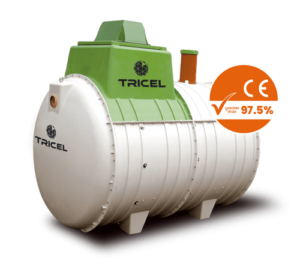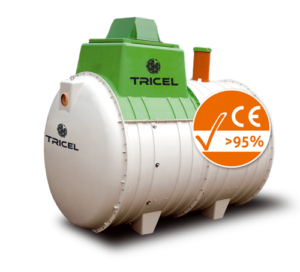What is the difference between a septic tank and a treatment plant? How do you choose?
Fact – All types of septic tanks collect wastewater from toilets, sinks, washing machines & showers.
Fact – All types of septic tanks need to be desludged yearly (emptied).
Fact – Wastewater from any type of septic tank, or sewage treatment tank will eventually reach a waterway.
The 3 possible options when it comes to installing a septic tank are:
- Standard septic tank – good soil drainage requires a large percolation area (100 linear metres). Suitable product: Tricel Vento septic tanks
- 95% treatment tank – good soil drainage with a smaller percolation area (50 linear metres). Suitable product: Tricel Novo wastewater treatment plants
- 97.5% treatment tank – wastewater is going directly into a waterway (river, stream). Suitable product: Tricel Vitae wastewater treatment plants
Wastewater contains pollutants like nitrates and phosphates which need to be removed before they reach rivers and lakes, otherwise pollution will happen and the water plants and animals die.
Your soil & the choice of a septic tank or wastewater treatment plant
Some soils allow the water to pass through too quickly (very sandy soils) and other soils allow the water to pass through too slowly (clay soil), causing the soil to become water-logged. The good bacteria will die in waterlogged soils, not good!
The type of soil we have around our homes can often determine the type of septic tank we are allowed to install!
So… ideally the wastewater should pass through the soil at the RIGHT speed to remove the pollutants! This doesn’t always happen and we sometimes need to “help out” the soil! This is why you may need a percolation area in place after your septic tank in order to spread the wastewater over the land so that it can pass through the soil at the correct speed to remove the pollutants. (What is a percolation area? – see below).
We are not allowed to pollute our waterways! This is why we must apply for a Consent to Discharge to the NIEA who will tell us the correct type of septic tank or wastewater treatment tank we are allowed to install. The law states you must have a Consent to Discharge from the Northern Ireland Environmental Agency (NIEA) in order to install any new septic tank or sewage treatment plant.
Please click on the link below to find out more information regarding Consent to Discharge forms. Or give us a ring if you want any help with filling in the forms or have any other questions.
Septic Tank or Wastewater Treatment Tank?
How are you supposed to know which type of tank you are meant to install?
Do you have a waterway available near your home? River, Stream, Sheough, open ditch.
- If the answer is YES then you will need a 97.5% Treatment tank. No percolation test is required! Please check out our Tricel Vitae Treatment Tank certified to > 97.5%.
- If the answer is NO then you will need to carry out a percolation test.
Percolation areas & Percolation tests explained
What is a percolation test?
A percolation test will calculate the drainage rate of the land in your site. The wastewater effluent leaving your septic tank or sewage treatment plant must safely drain away into the soil below. The result of the percolation test and how much land you have available to you will determine whether you can install a standard septic tank or a 95% Treatment tank.
You will need a digger on site to carry out a percolation test. Depawater can carry out percolation testing for you.
Outcome of Percolation Test
- If the results of the percolation test show that there is good drainage in the soil and you have sufficient land available to you then you may be allowed to install a standard septic tank going to a large percolation area (approx. 100 linear metres)
- If the results of the percolation test show good drainage but you have a smaller area of land available to you then you may have the option to install a 95% wastewater treatment plant with a smaller percolation area (approx. 50 linear metres).
What is a percolation area?
A percolation area (aka soakaway/drainage) is installed after your tank in order to slow the movement of water through the soil. It is a series of pipes with stones in/around them. The wastewater is then dispersed over a larger area and can pass through the soil more slowly before reaching a waterway. This allows the bacteria in the soil time to remove the pollutants from the wastewater.

Photograph showing an example of a percolation area being installed.
NOTE: The percolation area needs to be properly sized.
What’s the difference between a standard septic tank and a wastewater treatment tank?
Standard septic tank
A standard Septic Tank simply separates the wastewater from the sludge. The water that leaves the tank is not “treated” i.e the nitrates and phosphates are not removed by bacteria inside the tank. The untreated wastewater will leave the tank and enter a large percolation area where it will then pass through the soil at a speed which allows the bacteria in the soil to remove the nitrates and phosphates. The sludge remains in the tank and needs to be emptied out annually (desludged). Contact NI Water who will desludge your tank once a year free of charge if you are paying rates.
Wastewater treatment plants
A wastewater treatment tank has additional chamber/s where the wastewater is “treated” by bacteria. The bacteria present in the tank remove many of the nitrates and phosphates from the wastewater before it leaves the tank. These bacteria need oxygen to survive which is why a treatment tank needs electricity to run a compressor (pumps air into the tank).
A Tricel 97.5% Vitae treatment tank will remove MORE of the pollutants from the wastewater before it leaves the tank. This wastewater is directly discharged into a waterway so it important that it contains very few pollutants. No percolation area needs to be installed with this tank.
A Tricel 95% NOVO treatment tank will remove many of the pollutants from the wastewater before it leaves the tank and the remaining pollutants will be removed as it passes through the percolation area which is positioned after the treatment tank.
95% NOVO treatment tank – How it works – There are 3 chambers in this tank.
- Settlement chamber – heavier solids fall to the bottom creating sludge, the water travels into the next chamber.
- Aeration chamber – bacteria are present here to remove pollutants like nitrates and phosphates.
- Final settlement chamber – treated wastewater enters this chamber and small particles are finally removed before the wastewater leaves the tank and enters the percolation area.
If your consent to discharge allows you to install a 95% BOD treatment tank with a suitably sized percolation area then check out our Tricel NOVO 95% treatment tank.




